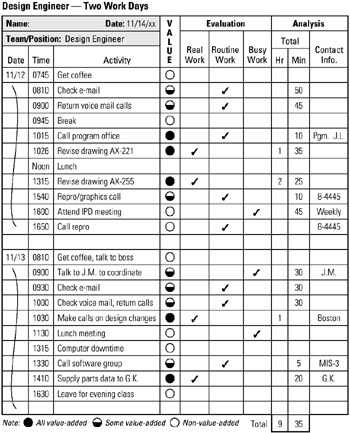Tool 5: Activity Analysis
| AKA | N/A |
| Classification | Analyzing/Trending (AT) |
Tool description
An activity analysis is a very useful tool to account for the time spent in everyday work schedules, programs, or project activities. It allows an analyst to uncover unnecessary work activities, time taken to complete highly important to unimportant activities, and provides data helpful to make work more efficient and effective.
Typical application
-
To analyze and evaluate work and time requirements to complete the work.
-
To identify ineffective work steps and procedures for the purpose of eliminating waste.
-
To account for time used within an eight-hour day or other predetermined time period.
Problem-solving phase
| → | Select and define problem or opportunity |
| → | Identify and analyze causes or potential change |
| Develop and plan possible solutions or change | |
| Implement and evaluate solution or change | |
| Measure and report solution or change results | |
| Recognize and reward team efforts |
Typically used by
| Research/statistics | |
| Creativity/innovation | |
| 3 | Engineering |
| Project management | |
| 2 | Manufacturing |
| Marketing/sales | |
| 4 | Administration/documentation |
| Servicing/support | |
| Customer/quality metrics | |
| 1 | Change management |
before
-
Time study sheet
-
Task analysis
-
Checksheet
-
Check list
-
Starbursting
after
-
Activity cost matrix
-
Value/Non-Value-Added Cycle Time Chart
-
Process analysis
-
Breakdown tree
-
Cluster analysis
Notes and key points
-
The following legend pertains to the example Design Engineer—Two Work Days.

Step-by-step procedure
-
STEP 1 An activity analysis form is prepared for the position, program, or project to be observed and analyzed. See example Design Engineer—Two Work Days.
-
STEP 2 Every activity that is considered important, time-consuming, or required work is timed and recorded on the form.
-
STEP 3 Other supporting activities are noted for the purpose of time accounting.
-
STEP 4 All activities are value-rated and coded as an all, some, non-value- added activity and recorded as such on the form, as shown in the example.
-
STEP 5 The totals column is summed to show time used in a specific period of time.
-
STEP 6 The form is completely filled out in order to provide background data for work simplification or process-improvement efforts.
-
STEP 7 Finally, the activity analysis form is reviewed and dated.
Example of tool application

EAN: 2147483647
Pages: 326